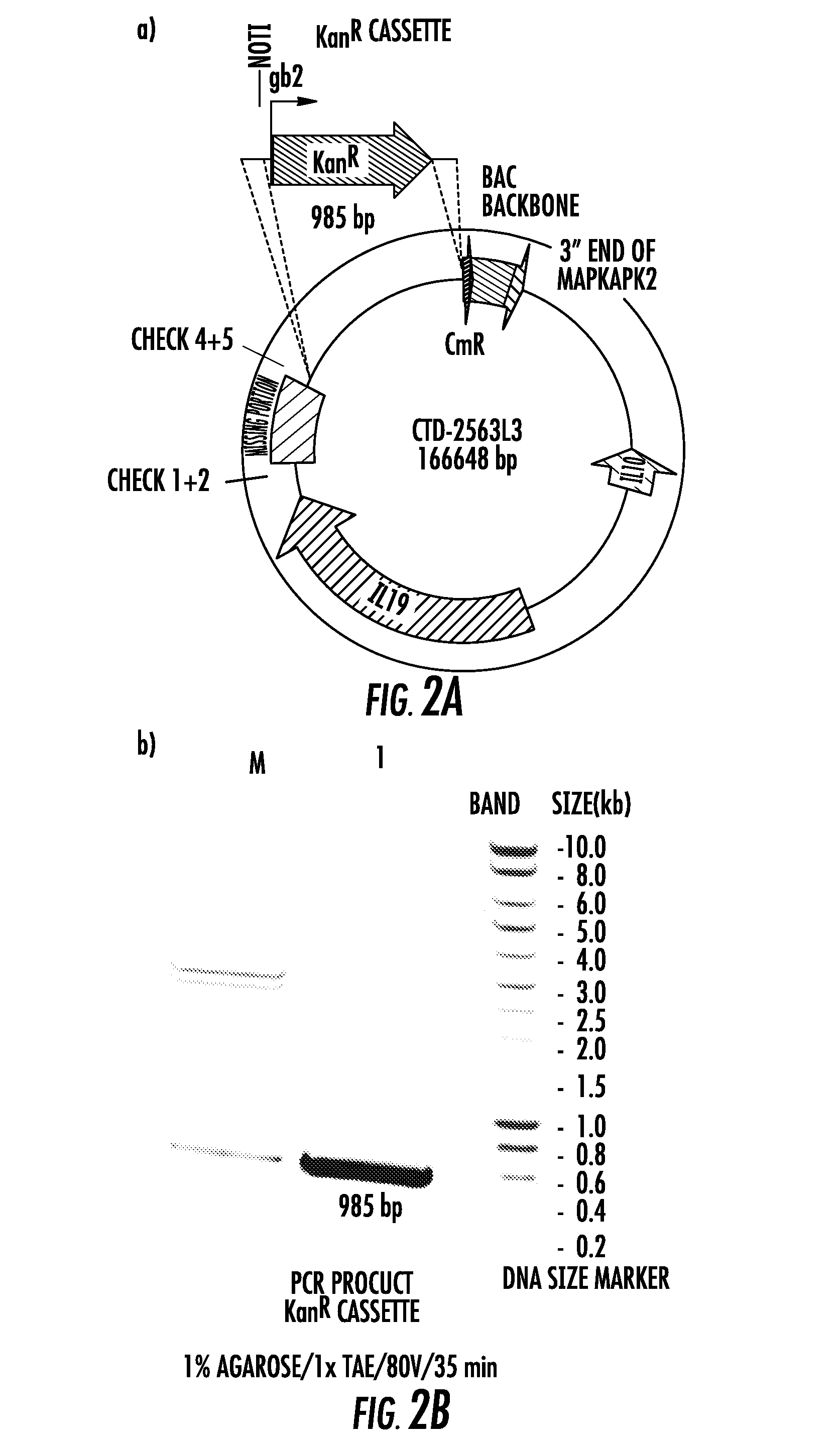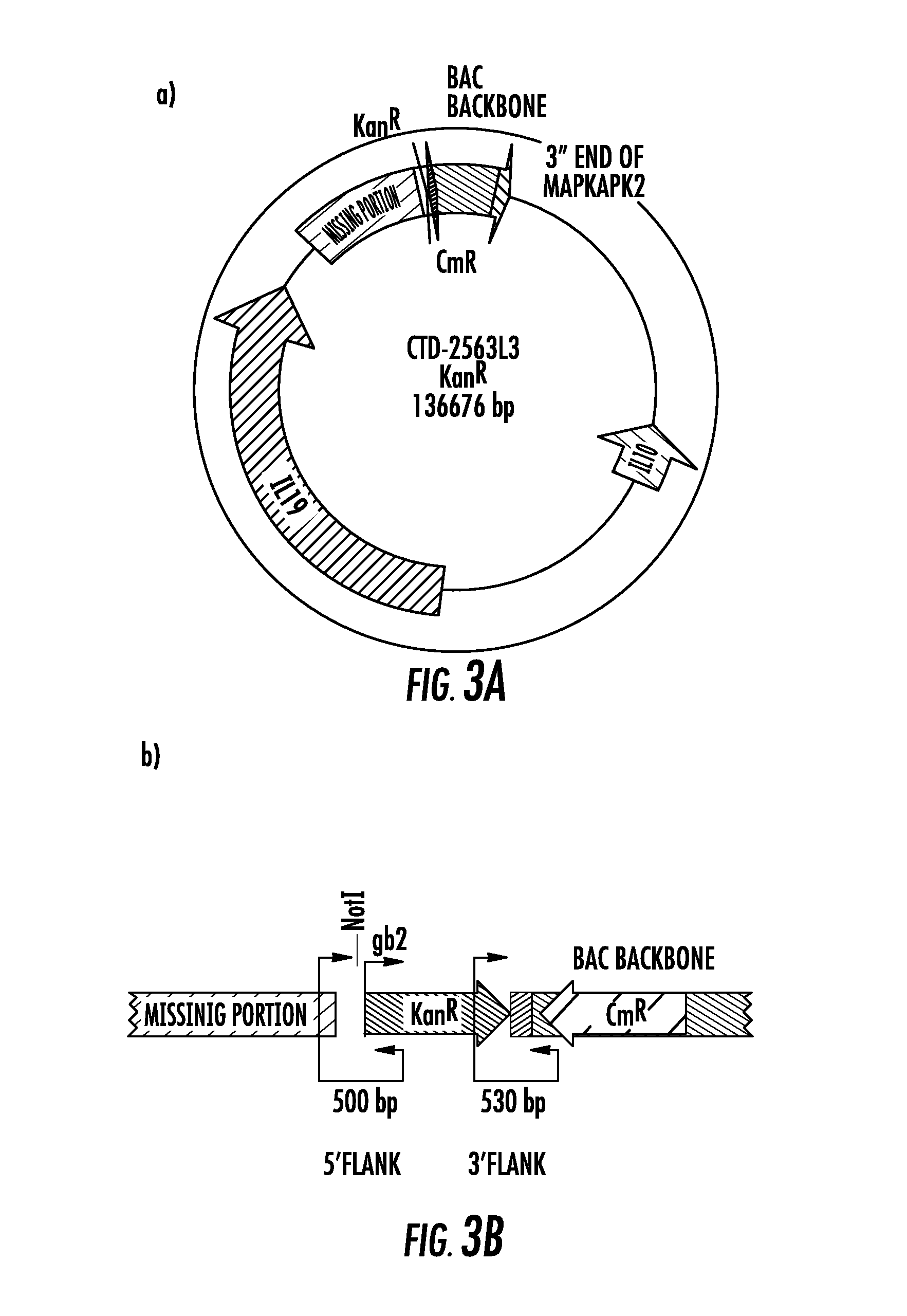Humanized transgenic single nucleotide polymorphism animal systems
- Summary
- Abstract
- Description
- Claims
- Application Information
AI Technical Summary
Benefits of technology
Problems solved by technology
Method used
Image
Examples
example 1
Construction of the original BAC (hIL10BAC-ATA)
[0068]We initiated a database search to identify a human bacterial artificial chromosome (BAC) derived from chromosome 1 in which the IL10 gene is situated approximately at the midpoint. The reason for this is to increase the likelihood that there would be a sufficient amount of genomic DNA surrounding the MO gene to reconstitute normal expression. Data from other BAC transgenic models suggest that a minimum of 50 kb of genomic sequence flanking a given gene is required to recapitulate normal expression. Heintz N. BAC to the future: the use of bac transgenic mice for neuroscience research. Nat Rev Neurosci 2001; 2:861-870. We identified a contig (accession number NT—021877) that consisted of 16,682,800 bp of genomic sequence. Blast searches confirmed the presence of the human genes encoding MAPKAPK2, IL10, and IL19. A BAC clone (RP11-262N9) was identified to contain these genes within the genomic sequence available for contig NT—021877,...
example 2
Construction of the New BAC (hIL10BAC-GCC)
[0070]We screened BAC libraries for clones containing the “GCC” haplotype in the IL10 locus and identified a particular clone (CTD-3174K1) that was very close in size to the original hIL10BAC, to create a new “GCC” strain. We generated a construct of the exact length of the original hIL10BAC construct to exclude any potential bias that could be introduced by differences in construct size and DNA content except for the SNPs carried by the different IL10 alleles. To replace the “missing 12.6Kb” of sequence in the “parent BAC” (CTD-3174K1), we identified a “donor BAC” that was from the same library which contained the IL10 promoter. It was important the donor BAC contained the IL10 promoter so that we could verify the GCC allele given that we did not know if the library was derived from an individual heterozygous at this locus. The experimental strategy used to create the GCC strain is illustrated in FIG. 7. In brief, the 12.6Kb fragment from t...
example 3
Construction of Transgenic Mouse System Expressing a Cytokine Receptor
[0089]BAC clones containing the genes encoding the human IL23 receptor (IL23R) (human IL23R and IL12RB) genes and regulatory regions is identified and used to created hIL23RBAC transgenic mice. The DNA is subjected to restriction enzyme digestion and the insert is purified for microinjection. The purified BACs are of appropriate length and are injected into fertilized mice (e.g., C57BL / 6). The founder mice are screened for the transgenes by Southern blot analysis. The surviving founder mice are mated with wildtype (WT) C57BL / 6 breeders to expand each colony. hIL23RBAC transgenic mice are created for wildtype hIL23R components as well as one or more SNP haplotypes within hIL23R. In certain embodiments, the inserts for the wildtype and SNP versions of hIL23R are the same length.
[0090]Mice from separate litters in each founder line are used to assess transgene copy numbers. Quantitative PCR assays are designed to det...
PUM
 Login to View More
Login to View More Abstract
Description
Claims
Application Information
 Login to View More
Login to View More - R&D
- Intellectual Property
- Life Sciences
- Materials
- Tech Scout
- Unparalleled Data Quality
- Higher Quality Content
- 60% Fewer Hallucinations
Browse by: Latest US Patents, China's latest patents, Technical Efficacy Thesaurus, Application Domain, Technology Topic, Popular Technical Reports.
© 2025 PatSnap. All rights reserved.Legal|Privacy policy|Modern Slavery Act Transparency Statement|Sitemap|About US| Contact US: help@patsnap.com



